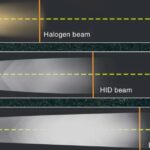Introduction
Car window tinting has become increasingly popular among vehicle owners, offering a range of benefits, such as enhanced privacy, protection against harmful UV rays, and improved aesthetics. However, many car owners are often left wondering about the cost implications of tinting their vehicle windows.
In this comprehensive guide, we’ll delve into the various factors that influence the cost of window tinting, explore different types, and provide valuable insights to help you make informed decisions.
Different Vehicles And The Cost Of Window Tints
When tinting car windows, the cost can vary depending on your vehicle type. Whether you have a coupe, sedan, SUV, truck, van, or a specific model like a Tesla, the price of window tinting may differ. Let’s take a closer look at the estimated cost range for window tinting based on different vehicle types:
| Vehicle Type | Cost Range for Window Tinting |
| Coupe | $190 – $550 |
| Sedan | $190 – $550 |
| SUV | $260 – $715 |
| Truck | Standard Cab: $160 – $450Extended Cab: $190 – $550Crew Cab: $210 – $600 |
| Van | $260 – $715 |
| Tesla | Model 5: $400 – $600Model X and Y: $450 – $715Model 3: $850+ |
These are approximate figures and may vary based on factors such as the size of the vehicle and the type of tint selected.
Window Tints At Vinyl Frog

If you’re considering window tinting for your car, Vinyl Frog offers a range of premium quality Heat Rejecting Window Tint Films. These films are composed of nano-ceramic particles, providing durability, scratch resistance, and efficient heat reduction. Let’s explore the different VLT (Visible Light Transmission) percentages available:
05% VLT Heat Rejecting Window Tint Film
- This tinted film allows only 5% of light to pass, offering maximum privacy and a fashionable appearance. However, it’s essential to check local laws before installation. Prices start from $59 for a 5ft x 3.28ft roll.
20% VLT Heat Rejecting Window Tint Film
- With a 20% VLT, this tint film helps keep your vehicle cool and protects the interior from UV damage. It also reduces glare and offers privacy. Prices range from $59 to $699, depending on the size.
35% VLT Heat Rejecting Window Tint Film
- Legal in most states, this tint film provides the benefits of tinting without compromising visibility. Prices vary from $59 to $699 based on size.
50% VLT Heat Rejecting Window Tint Film
- Ideal for maintaining visibility while reducing glare and enhancing privacy, this tint film blocks out 50% of light. Prices are similar to other VLT percentages, ranging from $59 to $699.
Benefits Of Window Tinting
Window tinting offers many benefits for car owners, making it a worthwhile investment. Let’s explore some of the key advantages:
Ensures Privacy
Tinted windows provide greater privacy, preventing prying eyes from peering into your vehicle. This can reduce the theft risk and enhance peace of mind, especially for solo travelers.
Enhances Safety
Safety is paramount on the road; window tinting contributes to safer driving conditions. By reducing glare and preventing glass shards from scattering in case of an impact, tinted windows help minimize the risk of accidents.
Window Tint Percentages
The percentage of light allowed to pass through window tint, known as VLT, plays a crucial role in determining its effectiveness. Higher VLT percentages allow more light to enter, while lower percentages offer greater privacy and heat reduction.
Protection Against Harmful Ultraviolet Rays
UV rays from the sun can cause damage to your skin and the interior of your vehicle. Window tinting is a barrier, blocking harmful UV rays and protecting you and your car’s interior from sun damage.
Health Benefits
In addition to protecting against UV rays, window tinting helps regulate the temperature inside your vehicle, reducing the need for excessive air conditioning. This not only enhances comfort but also contributes to fuel efficiency.
Fuel Efficiency
Window tinting can improve fuel efficiency by reducing the need for air conditioning, leading to cost savings in the long run. With more astounding interiors, your vehicle’s air conditioning system doesn’t have to work as hard, reducing fuel consumption.
Factors That Determine The Cost Of Window Tints
Several factors influence the cost of window tinting, including the type of tint, warranty coverage, quality of the tint film, vehicle model, window size and shape, and professional installation. Let’s delve into each factor in detail:
How To Remove The Window Tint Glue?
Removing window tint glue can be daunting, but it’s essential for maintaining the cleanliness and appearance of tinted windows. Here’s a step-by-step guide to removing window tint glue effectively:
- Gather Your Supplies: You’ll need a few essential tools, including a spray bottle filled with soapy water, a razor blade or scraper, a heat gun or hairdryer, and some clean, soft clothes.
- Prepare the Window: Start by spraying the soapy water onto the window and covering it with a plastic garbage bag. This will help soften the adhesive and protect the window from scratches.
- Apply Heat: Use the heat gun or hairdryer to apply heat to the window, focusing on one section at a time. The heat will loosen the adhesive, making it easier to remove.
- Scrape Off the Glue: Carefully use the razor blade or scraper to peel away the softened glue from the window. Work slowly and gently to avoid damaging the glass.
- Clean Up: Once you’ve removed all the glue, wipe down the window with a clean, soft cloth to remove any residue. You may need to repeat the process several times to remove the glue.
- Finish Up: Finally, thoroughly clean the window with glass cleaner to remove any remaining residue and restore its clarity.
Following these steps, you can effectively remove window tint glue and clean and clear your tinted windows.
Types Of Windows Tints And Cost
Regarding window tinting, several types of tint films are available, each with its features and cost considerations. Let’s explore the three main types of window tints:
Dyed Tint
The dyed tint is one of the most common types of window tinting films. It’s made by adding a black or colored dye to the film material, which helps block UV rays and reduce heat and light transmission. The dyed tint is generally more affordable than other types of tint films, with prices ranging from $100 to $400 depending on the make and model of your car.
Ceramic Tint
Ceramic tint is considered a high-end option known for its precise and heat-rejecting properties. It provides excellent UV protection and helps keep the car’s interior cool and comfortable. However, ceramic tints are more expensive than others, ranging from $350 to $800.
Carbon Tint
Carbon tint is made from a carbon-based film material known for its non-reflective, matte finish. It provides a sleek look to the car and is resistant to fading, bubbling, and cracking, making it a durable option for car owners. Carbon tints are available in various shades and can be easily installed to fit different types of vehicles. Prices for carbon film range from $180 to $650.
Other Window Tinting Cost Factors

In addition to the type of tint film, several other factors can influence the cost of window tinting. Let’s explore some of these factors:
Number and Complexity of Windows
The size, shape, and number of windows in your vehicle can affect the cost of window tinting. More oversized windows or windows with complex shapes may require more time and material to tint, resulting in higher costs.
Warranty
Warranty coverage is an important consideration when choosing a window tint. A good warranty can provide peace of mind and protect against defects, peeling, cracking, or bubbling. While warranties typically do not come at an extra cost, they can save you money in the long run by covering any issues that may arise.
Location and Laws
Location-specific laws and regulations may also impact the cost of window tinting. Some states have restrictions on the darkness of window tints or require tint certification, which can affect the installation cost. Familiarizing yourself with local laws and regulations before tinting your windows to avoid legal issues is essential.
Read More Posts
How Much Does It Cost To Wrap A Car In 2024?
How Long Do Car Batteries Last?
FAQs
How much does it cost to tint a car all around?
Tinting a car can cost between $200 and $700, depending on factors like the type of vehicle and tint film chosen.
What is the legal tint in Indiana?
The legal tint limit in Indiana is 30% visible light transmission (VLT) for the front side windows and any darkness for the back and rear windows.
What’s the legal tint in Florida?
The legal tint limit in Florida is 28% VLT for the front side windows and any darkness for the back and rear windows.
What is the darkest legal tint?
The darkest legal tint varies by state, but generally, it’s around 5% VLT for the rear side and rear windows in most states.
Conclusion
In conclusion, the cost of tinting car windows can vary depending on factors such as the type of tint film, vehicle model, and professional installation. Whether you opt for dyed, ceramic, or carbon tint, it’s essential to consider your specific needs and preferences.
By understanding the cost factors and benefits of window tinting, you can make an informed decision that enhances your vehicle’s comfort, privacy, and safety. Research thoroughly, consult with professionals, and comply with local laws and regulations for a successful window tinting experience.







